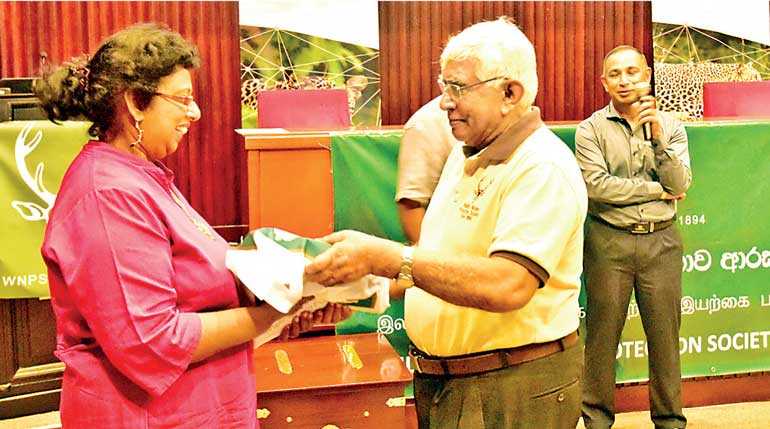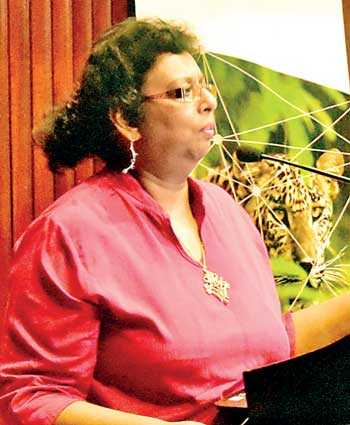Wednesday Dec 17, 2025
Wednesday Dec 17, 2025
Thursday, 12 December 2019 00:00 - - {{hitsCtrl.values.hits}}



By Medha de Alwis
Endemic to Sri Lanka and rated to be critically endangered by the International Union for Conservation of Nature (IUCN) Red List, the western purple-faced langur needs serious attention through conservation efforts.
At the Wildlife and Nature Protection Society (WNPS) November Lecture, Dr. Dela, a field researcher on primate ecology and behaviour who has worked for over 30 years on the subject, illustrated the behaviour and threats faced by the western purple-faced langur.

Current situation
Commonly referred to by local laymen as simply a ‘monkey’, the western purple-faced langur is no stranger to the residents of Sri Lanka. They frequent residential areas but are increasingly less welcome at home gardens in the Western Province. A large troop of the langurs ranging from the young to the old is a familiar visitor on a day when one stays home or more recently even around commercial offices in semi-urban areas. They are often chased away (ironically from their own habitat) or at times fed all types of food by people.
Interesting facts
The western purple-faced langur, scientifically known as Semnopithecus Vetulus Nestor, is one of the five subspecies of the purple-faced langur, Semnopithecus Vetulus. It is endemic to Sri Lanka. They mostly live in uni-male groups, yet bi-male or multi-male groups are also seen at times. Closely related to human beings, one would see the lead male of the tribe in a dominant position. Young males are chased from the troop as they grow up and this is a means of reducing inbreeding. 
Given a good setting of lush forest cover, one could witness the community of langurs grooming each other and letting the young play in their group, which has become a rarer sight as forests vanish.
There was incident reported where a mother langur held on to the dead body of her baby for 41 hours after death, still cradling and grooming the dead langur. Even after finally letting go of the carcass, she had kept watch for 10 hours. This demonstrates how sensitive and emotional they are, similar to their close relations, humans.
How threatened is the western purple-faced langur?
How did the langur reach critically endangered status? The primary threat they face is to their habitat. Forest fragmentation and forest degradation are grave concerns throughout the island, and the western purple-faced langur is one of the many victims of this sad situation. Electrocution is another threat, and one frequently sees a langur killed by electric wires. Forest patches have also become smaller with fragmentation and the transformation of their original homes into residential areas makes their original inhabitant unliveable.
Canopy covers are also fast vanishing and water sources will perish soon after, leaving the langur helpless after its feeding sites vanish.
After losing their original habitat of the forest, the western purple-faced langur adapted to home gardens. Though primarily leaf eaters, once they lost the ample forest leaf cover, they started feeding on succulent fruits in home gardens. But how much can one adapt when one sees one’s home being fragmented further and further?
Adaptation
After losing their original habitat of the forest, the western purple-faced langur adapted to home gardens. Though primarily leaf eaters, once they lost the ample forest leaf cover, they started feeding on succulent fruits in home gardens. But how much can one adapt when one sees one’s home being fragmented further and further?
Issues to be addressed
The home gardens too started getting fragmented. Residential plots are being further segmented into smaller land plots. And then where will the langur go? What will happen to him? Consideration has to be shown for the increase of the human population no doubt, and development must take place. Yet development needs to be sustainable and certainly should not come at the cost of a habitat’s first inhabitant, who is losing its home and being left with nowhere to go and nothing to feed upon. 
Enriching the forest patches is the need of the day, according to Sangeeth Silva, a young researcher who has delved extensively into the western purple-faced langur and its forest cover, under the guidance of Dr. Dela.
Forest fragmentation needs to be done with proper policy planning so that the species will not be further endangered. Steps can be taken to enrich the degraded patches and home gardens can be made a welcome site for langurs. Fruit trees such as jack, mango, tamarind, banana and papaya can be grown, which will be food sources for these poor animals. We cannot only share fruit with them but must also make our gardens cool havens. Imagine the aroma of fruit as you step into your garden full of trees and the playful langurs frolicking and basking in its shade.
After all, having chased away our habitats’ original inhabitants so unfairly and ruthlessly, the least we can do is to apologetically welcome them back and share our gardens with them. We need to be respectful of the fact that they had left their land for us when we came in. They looked for alternatives, found them and painstakingly adjusted to these new situations. In fact they had to as there was no other way. They had to come back to our gardens because these alternate measures they found too have perished. Therefore, it is our duty to the langur and to ourselves that paths be paved for sustainable living, at least now. That is perhaps the only way to go if we want this already critically endangered endemic species to stop heading towards extinction.
(The writer is a freelance lawyer and journalist. She can be contacted at [email protected])